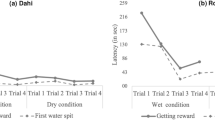Abstract
This study investigated the ability of three chimpanzees and three orangutans to track the position of a reward after a series of displacements. The reward was placed under one of two opaque containers resting on a platform. Experiment 1 investigated rotational displacements in which the platform was rotated 0°, 180°, or 360°. Experiment 2 investigated transpositional displacements in which the platform remained stationary while the containers either remained stationary, or swapped their positions (in a one- two- or three-step sequence). In both experiments, the initial position of the reward was indicated either by directly showing the reward under the containers, or by placing a landmark, which had been previously associated with the reward, on top of the baited container. Subjects successfully tracked the reward through rotations and transpositions when they had seen it, but their performance substantially deteriorated when the landmark indicated the reward's initial position, even though subjects successfully used the landmark to find the reward in the absence of displacements. This decrease was especially pronounced in rotational displacements. A language-trained orangutan outperformed all the other apes and solved all problems.




Similar content being viewed by others
References
Anderson JR, Awazu S, Fujita K (2000) Can squirrel monkeys (Saimiri sciureus) learn self-control? A study using food array selection tests and reverse-reward contingency. J Exp Psychol Anim Behav Proc 26:87–97
Beran MJ, Minahan MF (2000) Monitoring spatial transpositions by bonobos (Pan paniscus) and chimpanzees (Pan troglodytes). Int J Comp Psychol 13:1–15
Blois ST de, Novak MA (1994) Object permanence in rhesus monkeys (Macaca mulatta). J Comp Psychol 108:318–327
Blois ST de, Novak MA, Bond M (1998) Object permanence in orangutans (Pongo pygmaeus) and squirrel monkeys (Saimiri sciureus). J Comp Psychol 112:137–152
Boysen ST, Berntson GG, Hannan MB, Cacioppo JT (1996) Quantity-based interference and symbolic representations in chimpanzees (Pan troglodytes). J Exp Psychol Anim Behav Proc 22:76–86
Bremner JG (1978) Egocentric versus allocentric spatial coding in nine-month-old infants: factors influencing the choice of code. Dev Psychol 14:346–355
Call J (2001) Object permanence in orangutans (Pongo pygmaeus), chimpanzees (Pan troglodytes), and children (Homo sapiens). J Comp Psychol 115:159–171
Call J, Tomasello M (1998) Distinguishing intentional from accidental actions in orangutans (Pongo pygmaeus), chimpanzees (Pan troglodytes), and human children (Homo sapiens). J Comp Psychol 112:192–206
Call J, Tomasello M (1999) A nonverbal theory of mind test. The performance of children and apes. Child Dev 70:381–395
Doré FY (1986) Object permanence in adult cats (Felis catus). J Comp Psychol 100:340–347
Doré FY (1990) Search behavior of cats (Felis catus) in an invisible displacement test: cognition and experience. Can J Psychol 44:359–370
Gagnon S, Doré FY (1992) Search behavior in various breeds of adult dogs (Canis familiaris): object permanence and olfactory cues. J Comp Psychol 106:58–68
Gagnon S, Doré FY (1993) Search behavior of dogs (Canis familiaris) in invisible displacement problems. Anim Learn Behav 21:246–254
Lasky RE, Romano N, Wenters J (1980) Spatial localization in children after changes in position. J Exp Child Psychol 29:225–248
Miles HLW (1990) The cognitive foundations for reference in a signing orangutan. In: Parker ST, Gibson KR (eds) "Language" and intelligence in monkeys and apes. Cambridge University Press, Cambridge, pp 511–539
Miles HLW (1994) ME CHANTEK: the development of self-awareness in a signing orangutan. In: Parker ST, Mitchell RW, Boccia ML (eds) Self-awareness in animals and humans. Developmental perspectives. Cambridge University Press, Cambridge, pp 254–272
Natale F, Antinucci F, Spinozzi G, Potì P (1986) Stage 6 object concept in nonhuman primate cognition: a comparison between gorilla (Gorilla gorilla gorilla) and Japanese macaque (Macaca fuscata). J Comp Psychol 100:335–339
Pepperberg IM, Funk MS (1990) Object permanence in four species of psittacine birds: an African grey parrot (Psittacus erithacus), an Illiger mimi macaw (Ara maracana), a parakeet (Melopsittacus undulatus), and a cockatiel (Nymphicus hollandicus). Anim Learn Behav 18:97–108
Piaget J (1954) Construction of reality in the child. Norton, New York
Potì P (2000) Aspects of spatial cognition in capuchins (Cebus apella): frames of reference and scale of space. Anim Cogn 3:69–77
Premack D (1983) The codes of man and beasts. Behav Brain Sci 6:125–167
Premack D (1988) 'Does the chimpanzee have a theory of mind?' revisted. In: Byrne RW, Whiten A (eds) Machiavellian intelligence. Social expertise and the evolution of intellect in monkeys, apes, and humans. Oxford University Press, New York, pp 160–179
Roberts WA (1998) Principles of animal cognition. McGraw-Hill, Boston
Schino G, Spinozzi G, Berlinguer L (1990) Object concept and mental representation in Cebus apella and Macaca fascicularis. Primates 31:537–544
Sophian C (1984) Spatial transpositions and the early development of search. Dev Psychol 20:21–28
Sophian C (1985) Understanding the movements of objects—early developments in spatial cognition. Br J Dev Psychol 3:321–333
Sophian C, Sage S (1983) Developments in infants' search for displaced objects. J Exp Child Psychol 35:143–160
Thinus-Blanc C (1996) Animal spatial cognition. World Scientific, London
Thompson RKR, Oden DL, Boysen ST (1997) Language-naive chimpanzees (Pan troglodytes) judge relations between relations in a conceptual matching-to-sample task. J Exp Psychol Anim Behav Proc 23:31–43
Vauclair J (1996). Animal cognition. An introduction to modern comparative cognition. Harvard University Press, Cambridge, Mass.
Visalberghi E (1986) Aspects of space representation in an infant gorilla. In: Taub DM, King FA (eds) Current perspectives in primate social dynamics. Van Nostrand Reinhold, New York, pp 445–452
Acknowledgements
This investigation was supported in part by a grant RR-00165 from the National Center for Research Resources to the Yerkes Regional Primate Research Center. The Yerkes Center is fully accredited by the American Association of Laboratory Animal Care.
Author information
Authors and Affiliations
Corresponding author
About this article
Cite this article
Call, J. Spatial rotations and transpositions in orangutans (Pongo pygmaeus) and chimpanzees (Pan troglodytes). Primates 44, 347–357 (2003). https://doi.org/10.1007/s10329-003-0048-6
Received:
Accepted:
Published:
Issue Date:
DOI: https://doi.org/10.1007/s10329-003-0048-6




